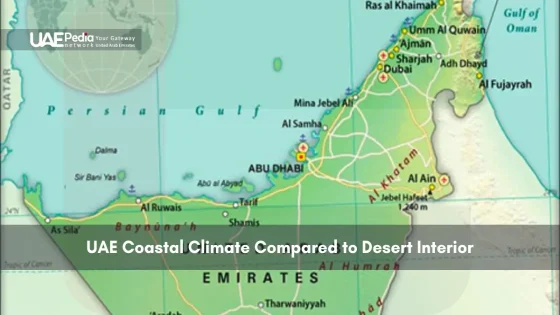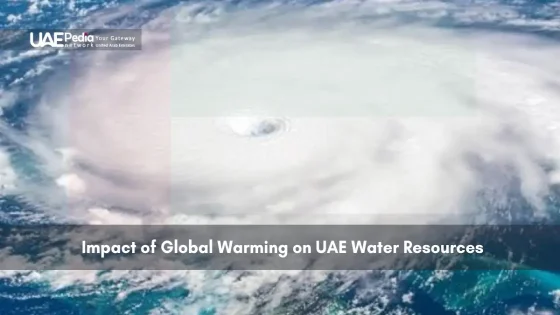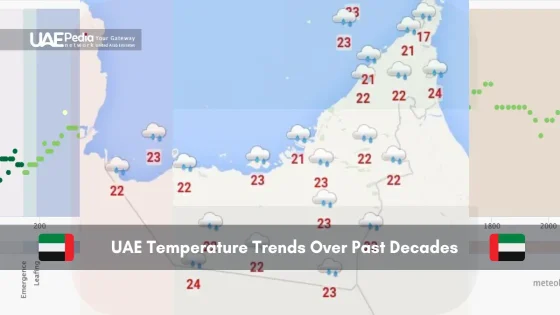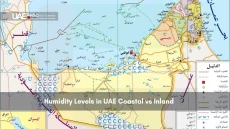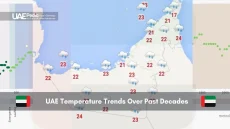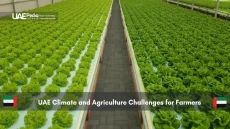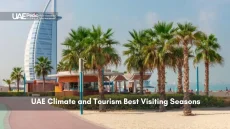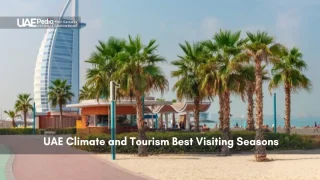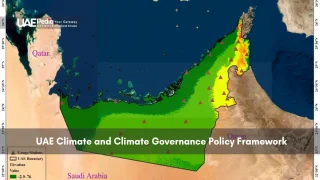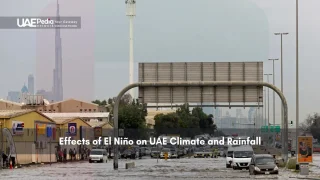Did you know the air you breathe changes dramatically within a 90-minute drive across the United Arab Emirates? Coastal breezes carry salt-kissed humidity, while desert winds whisper dry heat—a duality shaping life in this vibrant nation.
This guide unpacks how geography crafts two distinct worlds. Along the coast, gentle sea winds soften the sun’s intensity. Inland, vast desert expanses bake under relentless skies. Both environments influence everything from architecture to agriculture, creating a fascinating study in contrasts.
We’ll explore how elevation, proximity to water, and shifting sands create microclimates. You’ll see why understanding these patterns matters—whether you’re planning a beach day or a dune safari. Spoiler: packing sunscreen and a light sweater isn’t a bad idea.
Key takeaways:
- Coastal and desert zones create a “weather seesaw” with unique temperature swings
- Geographic features like the Hajar Mountains act as natural climate regulators
- Both systems work together to sustain the region’s biodiversity and urban growth
Overview of UAE’s Geographical and Climatic Landscape
Imagine swapping flip-flops for hiking boots without leaving the country—welcome to the Emirates’ geographic extremes. This sun-drenched nation straddles two worlds: shimmering shorelines and endless sand seas, each sculpted by forces older than Bedouin trade routes.
Geographic Context of the Arabian Peninsula
The UAE sits like a jewel where the Arabian Gulf meets the Sea of Oman. To the west, salt flats bleed into Saudi Arabia’s Empty Quarter—the largest sand desert on Earth. Eastward, the Hajar Mountains rise like nature’s skyscrapers, catching moisture to feed hidden wadis.
Introduction to Coastal and Desert Regions
Abu Dhabi’s sprawling emirate showcases this duality best. Its 700 km coastline cradles mangrove forests and luxury resorts, while inland areas dissolve into rippling dunes. Recent data reveals something surprising: these contrasting land types actually stabilize each other’s ecosystems.
| Feature | Coastal Zones | Desert Interior |
|---|---|---|
| Annual Rainfall | 120 mm | 80 mm |
| Summer Humidity | Up to 90% | Below 15% |
| Key Cities | Dubai, Abu Dhabi | Al Ain, Liwa |
Climate scientists note that rising temperatures affect both region types differently—a conversation we’ll unpack later. For now, remember this: every grain of sand and drop of seawater here tells a story of survival.
In-Depth Look at the UAE Coastal Climate
Ever felt the air thick enough to swim through? That’s summer along the shoreline, where the ocean’s breath shapes daily life. Let’s unpack what makes these seaside zones tick—from their signature humidity hugs to surprising weather twists.
Key Characteristics and Seasonal Patterns
The sea acts like nature’s thermostat here. Summer thermometers regularly hit 104°F (40°C), but water proximity keeps nights 15°F warmer than inland deserts. “It’s not just the heat—it’s the moisture marathon,” notes Abu Dhabi-based meteorologist Rashid Al-Mansoori. Winter brings relief, with January averages dipping to 75°F (24°C).
Three seasonal forces rule:
- April-June: “Shoulder season” winds mix Gulf warmth with cooler air masses
- July-September: Peak humidity (85%+) creates that famous “air you wear” feeling
- October-March: Ideal beach weather with rare rainfall surprises
| Condition | Summer | Winter |
|---|---|---|
| Daytime Highs | 104°F (40°C) | 77°F (25°C) |
| Night Lows | 86°F (30°C) | 61°F (16°C) |
| Rainfall Days | <1 | 3-5 |
These humidity trends aren’t just small talk—they influence building codes and outdoor work hours. Recent years saw record-breaking 122°F (50°C) days, pushing cities to innovate cooling solutions. Yet between extreme heat waves, gentle sea breezes still whisper through date palms most evenings.
Exploring the Desert Interior and Its Extreme Conditions
Ever wondered how a single day in the desert can feel like four seasons? Venture beyond the shoreline, and you’ll swap humid breezes for nature’s most dramatic theater—where survival demands constant reinvention.
Temperature Fluctuations and Heat Stress
Dawn here isn’t gentle—it’s a starting gun. By noon, sand surfaces can hit 158°F (70°C), hot enough to fry an egg. Yet nighttime often plunges below 50°F (10°C). This 100-degree swing isn’t just a weather quirk—it’s a daily endurance test for all life forms.
Heat stress reshapes routines. Bedouin herders still time treks by star positions, avoiding midday sun. Modern infrastructure faces its own battles: asphalt melts, power grids strain, and shaded rest zones become lifelines. “The desert doesn’t negotiate,” says environmental researcher Amal Khalid. “You adapt or retreat.”
| Time | Summer High | Winter Low |
|---|---|---|
| Daytime | 122°F (50°C) | 75°F (24°C) |
| Night | 86°F (30°C) | 41°F (5°C) |
| Record Extreme | 136°F (58°C) in 2021 | |
Desert Ecosystem Dynamics
Life here thrives on contradictions. Ghaf trees sink roots 100+ feet to hidden aquifers. Sand gazelles recycle moisture from plants they eat. Even the iconic dunes—some taller than the Statue of Liberty—shift shape daily, sculpted by winds carrying ancient mineral secrets.
Three survival strategies dominate:
- Timing: Nocturnal hunters like desert foxes avoid daytime heat
- Storage: Camel humps hold fat, not water—a common myth busted
- Cooperation: Shrubs create microclimates for insects and reptiles
Recent decades show worrying trends. Sandstorms now occur 25% more frequently than in the 1990s, while rare rainfall events grow unpredictable. Yet these harsh lands still birth miracles—like sudden flower blooms after decades-long droughts.
Differentiating the Marine and Terrestrial Environments
Picture this: turquoise waves sculpting shorelines while desert winds carve stone—two artists shaping vastly different masterpieces. Where saltwater meets sand dunes, nature reveals its knack for crafting opposites that somehow coexist.
Coastal Erosion, Beaches, and Reefs
That postcard-perfect beach? It’s always changing. Waves gnaw at shorelines, moving up to 3 meters of sand yearly in some areas. Coral reefs act as natural breakwaters, but rising temperatures threaten these underwater cities. Dubai’s Palm Islands show how human projects can accelerate erosion patterns—a reminder that every action ripples through ecosystems.
| Feature | Marine Zones | Desert Zones |
|---|---|---|
| Erosion Rate | High (2-5m/year) | Low (0.1m/year) |
| Water Sources | Seawater, rainfall | Underground aquifers |
| Key Habitats | Coral reefs, mangroves | Sand dunes, salt flats |
Desert Landforms and Hyper-Arid Areas
Inland, water plays hard to get. Less than 4 inches of rain falls annually in hyper-arid regions—when it comes, it often arrives in flash floods. Yet life persists: 52 plant species thrive in Liwa’s dunes alone, their roots tunneling deep to sip hidden moisture.
Three survival stories stand out:
- Mangroves filtering salt from seawater through specialized roots
- Desert foxes getting hydration from prey instead of drinking
- Sandstone formations preserving rainfall patterns from millennia past
These habitats aren’t just scenery—they’re living archives. Reefs record ocean health like tree rings, while shifting dunes map wind patterns over centuries. Protecting both requires understanding their fragile dance with water and time.
Impact of Climate Change on Coastal Waters and Deserts
Picture your favorite beach vanishing inch by inch each year—or ancient dunes swallowing highways whole. Our planet’s shifting rhythms are rewriting landscapes here faster than anywhere else. Let’s unpack how these changes ripple through both water and sand.
Rising Sea Levels and Marine Heatwaves
Oceans here aren’t just warming—they’re staging a quiet rebellion. Since 1990, regional sea levels rose 3.2 inches, threatening 85% of shoreline infrastructure. Coral reefs now face 10x more heatwaves than in the 1980s. “We’re watching entire ecosystems pivot,” says marine biologist Layla Hassan. “Fish species migrate north, while bleached corals struggle to rebuild.”
Desertification and Environmental Stress
Inland, the earth cracks under new pressures. Over 75% of desert soils show accelerated degradation, with sandstorms increasing by 30% since 2000. Rare rainfall events now dump a year’s water in hours, eroding ancient dunes instead of nourishing them. Farmers report crops failing two weeks earlier each decade.
| Climate Impact | Coastal Zones | Desert Zones |
|---|---|---|
| Temperature Rise | +2.1°F since 2000 | +3.4°F since 2000 |
| Key Threat | Saltwater intrusion | Dust bowl formation |
| Adaptation Focus | Mangrove restoration | Solar farm expansion |
Communities aren’t just watching—they’re innovating. Floating solar panels now dot reservoirs, while AI-powered irrigation saves 40% more water than traditional methods. As one Bedouin elder told me: “The desert taught us survival. Now we teach the world.”
Regional Geographic Influences on Weather Patterns
What if two seas could throw a weather party? That’s essentially what happens daily along the Arab Emirates’ edges. The Arabian Gulf and Sea of Oman don’t just border the country—they’re master chefs stirring up distinct atmospheric recipes.
When Neighboring Waters Collide
The Gulf’s shallow basin (avg. depth 115 ft) heats up like a skillet in summer, pumping humidity northward. Meanwhile, the deeper Sea of Oman (12,000 ft trenches) acts as a natural air conditioner. “These water bodies are siblings with opposite personalities,” explains meteorologist Fatima Al-Harbi. “One brings the steam, the other brings the breeze.”
| Feature | Arabian Gulf | Sea of Oman |
|---|---|---|
| Summer Water Temp | 95°F (35°C) | 82°F (28°C) |
| Wind Patterns | Northwesterly (Shamal) | Southeasterly (Khareef) |
| Rainfall Influence | Winter drizzle | Monsoon moisture |
This aquatic tug-of-war creates microclimates you can literally walk between. Head east from Dubai Marina, and you’ll swap sticky sidewalks for crisp mountain air within 90 minutes. The region’s Hajar Mountains amplify this contrast, trapping Gulf humidity on their western slopes while letting Sea of Oman breezes flow freely eastward.
These dynamics don’t exist in isolation. The Arab Emirates’ position at the heart of the Middle East makes it a weather crossroads. Summer winds carry desert dust from Iraq, while winter currents bring Indian Ocean moisture. It’s this interplay that gives the country its “four seasons in one day” reputation.
“Our weather isn’t just local—it’s a conversation between continents,” says climate researcher Dr. Omar Nasser. “The Gulf whispers to the Himalayas, while the Oman Sea chats with East Africa.”
Human Adaptation and Infrastructure Resilience
What if skyscrapers could sweat? In Abu Dhabi, architects design buildings that practically do—breathable facades and wind-channeling towers cool cities naturally. This isn’t sci-fi; it’s smart adaptation to extreme conditions reshaping urban landscapes.
Blueprint for Tomorrow’s Cities
Coastal planners now build “living shorelines”—rocky breakwaters that grow coral while protecting against storms. The capital’s new Al Jubail Island development uses elevated walkways and mangrove buffers to combat rising tides. “We’re not fighting nature anymore,” says urban designer Mariam Al-Mehairi. “We’re learning its rhythms.”
Three innovations stand out:
- Solar-powered streetlights doubling as emergency cooling stations
- AI-managed water grids reducing waste by 35%
- Heat-reflective road surfaces lowering neighborhood temps by 9°F
Renewable energy drives these efforts. The Mohammed bin Rashid Solar Park now powers 320,000 homes—a model replicated across UAE. Private firms join the push, with desert data centers using 40% less cooling through geothermal tech.
Government partnerships accelerate change. Abu Dhabi’s Climate Resilience Code mandates green roofs and shade structures in new builds. Meanwhile, Liwa’s smart farms grow salt-tolerant crops using desalination byproducts. As one engineer quipped: “Our blueprint? Make the impossible look easy.”
Comparative Analysis: Gulf Coast versus Inland Deserts
Ever packed sunglasses and a sweater for the same outing? That’s life along the Gulf’s edge versus desert heartlands. Let’s break down how these neighbors craft wildly different days—even when the sun shines equally bright.
Temperature, Rainfall, and Weather Variability
Summer along the shoreline feels like stepping into a steamy shower—average highs hit 104°F with 85% humidity. Head inland, and dry heat spikes to 122°F while humidity plummets below 15%. “It’s not just hotter in the desert—it’s a different kind of heat,” explains meteorologist Yasmin Al-Farsi. “Your sweat evaporates before you feel it.”
| Month | Gulf Coast High | Desert High | Rainfall (inches) |
|---|---|---|---|
| July | 104°F | 122°F | 0.1 |
| January | 75°F | 68°F | 0.8 |
| April | 91°F | 99°F | 0.3 |
Rain plays favorites too. Coastal zones get 60% more annual showers than deserts—though “more” means 4-5 drizzle days versus 1-2 inland downpours. Winter reveals another twist: deserts can dip below 50°F at night while shoreline temps stay balmy.
Compare this to the broader Middle East, where mountain ranges often dictate weather patterns. Here, flat landscapes let sea and sand clash directly—no mediators. The result? Two climate zones separated by less than 100 miles, each rewriting rulebooks on survival.
“You’re not just crossing geography—you’re time-traveling through weather eras,” says climate blogger Rashed Al-Mazroui. “Palm-fringed beaches feel tropical, while dunes echo Earth’s drier epochs.”
Next time you check a weather app here, look beyond the numbers. Those digits tell stories of sea breezes wrestling desert winds—a daily showdown shaping life in every sand grain and salt spray.
Exploring Biodiversity and Ecosystem Services
Ever seen a fish that farms its own food? Welcome to nature’s ingenuity—where survival sparks creativity. The region’s contrasting landscapes host species that rewrite biology textbooks daily. From neon-colored coral cities to dunes hiding living fossils, life here thrives on extremes.
Marine Life and Coral Reefs
Beneath turquoise waves, clownfish tend algae gardens while hawksbill turtles cruise like underwater blimps. These reefs shelter 1,200+ marine species—30% found nowhere else. Mangroves nearby act as fish nurseries, their tangled roots filtering salt from water through natural desalination.
Three reef superstars stand out:
- Parrotfish producing 800 lbs of sand yearly from eaten coral
- Blue-spotted stingrays detecting prey’s electrical pulses
- Acropora corals growing faster here than any tropical area
Desert Flora and Fauna Adaptations
Inland, nature plays a different game. Ghaf trees survive on 3.5 inches of annual rain by tapping underground rivers 100 ft deep. Sand cats hunt scorpions with fur-covered paws that silence footsteps—evolution’s perfect stealth tech.
| Feature | Marine Ecosystems | Desert Ecosystems |
|---|---|---|
| Species Count | 1,200+ | 52 plants, 28 mammals |
| Key Service | Carbon storage | Soil stabilization |
| Survival Trick | Symbiotic partnerships | Moisture recycling |
These habitats aren’t just pretty—they’re life-support systems. Coral reefs buffer 97% of wave energy during storms, while desert shrubs prevent 40 million tons of sand from blowing into cities yearly. Research highlights their $3.8 billion annual economic value through tourism and fisheries.
Next time you walk a beach or desert trail, look closer. That seashell or beetle? It’s part of a world where every species holds masterclass lessons in resilience.
National Efforts in Climate Adaptation and Environmental Protection
What if solar panels could grow crops? In the Emirates, they’re trying—agrivoltaic farms now merge food production with clean energy generation. This bold thinking defines the nation’s approach to safeguarding its future. Decades of research and extreme weather events have forged a playbook balancing innovation with tradition.
Policy Initiatives and International Collaborations
Abu Dhabi’s climate action plan targets 60% carbon cuts by 2035. Partnering with NASA, they’ve mapped underground aquifers using satellite tech—vital for managing scarce rainfall. The Emirates Nature-WWF partnership trains 10,000 citizen scientists yearly to monitor coastal ecosystems.
Three game-changing policies emerged recently:
- Mandatory green building codes in all seven emirates
- Regional coral reef protection pact with 15 Gulf nations
- AI-powered early warning systems for dust storms
Innovations in Renewable Energy and Sustainability
Dubai’s Mohammed bin Rashid Solar Park now spans 122 square miles—bigger than Paris. Its latest phase uses floating panels that reduce water evaporation by 70%. “We’re turning sunlight into solutions,” says engineer Khalid Al-Mansoori, showing how the park powers 320,000 homes nightly.
| Project | Impact | Tech Used |
|---|---|---|
| Al Dhafra Solar | 2 million tons CO2 reduction | Bifacial panels |
| Masdar City | 40% less energy use | Wind towers + AI |
| Liwa Oasis | 30% water savings | Root-zone irrigation |
These efforts extend beyond borders. The UAE-Pacific Partnership Fund has installed solar grids in 11 island nations since 2013. Back home, ancient falaj irrigation systems inspire modern water networks—proving old wisdom and new tech can flow together.
Final Reflections on UAE’s Coastal and Desert Climates
What if your morning coffee steam told tomorrow’s weather story? Over the past decade, summer highs here have climbed 3°F—a small number with big consequences. Coastal humidity now lingers longer, while desert nights warm faster than days. These shifts aren’t just numbers—they’re real-life plot twists in the Emirates’ environmental saga.
Data reveals a clear pattern: rainfall events grow fiercer but less predictable. The record-breaking April 2024 downpour—the heaviest in 75 years—flooded highways but refilled parched aquifers. Such extremes highlight why understanding climate zones matters more than ever.
Abu Dhabi’s 2035 sustainability plan shows how cities adapt. Solar farms now bloom where dunes once ruled, while AI weather models predict dust storms weeks in advance. Yet nature still holds surprises—like winter fog blanketing Liwa’s dunes, a phenomenon once as rare as snowfall.
Here’s the takeaway: every degree and raindrop tells a story of balance. Coastal breezes temper desert heat, while underground aquifers sustain life in hyper-arid regions. Our role? Keep learning from these systems while supporting green innovations. After all, the Emirates’ future isn’t just about surviving extremes—it’s about thriving through them.
Coastal areas like Abu Dhabi average 40°C (104°F) with humidity, while Liwa’s dunes hit 48°C (118°F) but feel drier. Sea breezes soften coastal heat, whereas desert nights cool faster—a key detail for planning hikes or beach days!
Mountain ranges near Fujairah trap moisture from the Gulf of Oman, bringing 140mm annual rain to the east coast. Inland deserts like Al Ain might see just 60mm—a stark contrast shaped by geography and shamal wind patterns.
Yes. Marine heatwaves stress reefs near Dibba Rock, but initiatives like Dubai’s Reef Restoration Project use 3D-printed structures to rebuild habitats. Mangrove planting in Umm Al Quwain also combats coastal erosion—proof of nature-tech teamwork!
Arabian oryx reduce activity during midday, while ghaf trees tap groundwater 30m deep. Sandfish lizards “swim” under dunes, and camel nostrils close during sandstorms—evolution’s genius at work in hyper-arid zones.
Palm Jumeirah’s breakwaters reduce wave energy by 80%, while Abu Dhabi’s “blue carbon” projects protect mangroves. Smart drainage systems in Jebel Ali prevent flooding—balancing luxury with climate resilience.
Absolutely! High salinity (up to 43 ppt vs. 35 ppt globally) slows evaporation, intensifying humidity. Desalination plants address freshwater needs but require energy—why solar-powered stations like Noor Abu Dhabi are game-changers.
These coastal marshes near Ras Al Khaimah store carbon 40x faster than rainforests and host migratory birds like flamingos. They’re natural barriers against storm surges—a fragile balance protected by UAE’s Ramsar wetland commitments.
